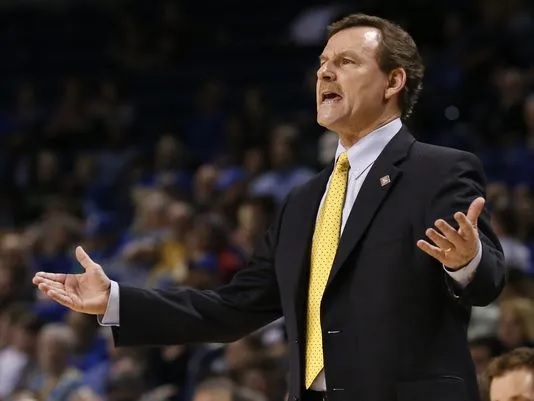William & Mary Reminds Us That College Basketball is Really a Business

It seems like a day doesn’t go by this time of year without another reminder that college athletics is really a major business that likes to pretend it is something more noble and altruistic.
Full disclosure that today’s example is a bit personal and especially frustrating for me because it involves a former colleague who has spent his entire career representing all the positive attributes that college sports supposedly are about.
After 16 years of success that is unparalleled in the history of William & Mary men’s basketball, the college has decided to part ways with 65-year-old head coach Tony Shaver.
In a statement, Athletic Director Samantha Huge said that “We have high expectations for our men’s basketball program, including participating in the NCAA tournament, and we will not shy away from setting the bar high. Now is the time to begin a new chapter in William & Mary basketball.”
That sounds all well and good, but what Huge seems to not understand is that prior to the arrival of Shaver, “high expectations” for the men’s basketball program basically meant double-digit victories every few years.
Shaver’s record during his 16 years at William & Mary is a textbook example of statistics not telling the complete story.
His overall record at W&M was 226-268 (.457), which certainly is not something that gets you a statue at most schools. However, you have to consider that in the 20 years prior to his arrival W&M posted an overall record of 207-348 (.373).
During his tenure, Shaver posted seven winning campaigns, including four seasons of 20 or more victories. W&M had only three winning seasons in the 20 years before Shaver and in the history of the basketball program (which dates back to 1905) had only five 20 win seasons before his arrival (and only two since 1951).
Over the last decade, W&M has posted a 161-155 record, which marks the first winning decade for the Tribe since the 1950s.
Even though W&M finished the 2018-2019 season with their first losing record (14-17) since 2013, they still finished with a winning record in Colonial Athletic Conference play for the sixth straight year and eighth time in Shaver’s career. In their 18 years in the CAA before Shaver arrived, W&M had a winning conference record one time.
For some, the “elephant in the room” is that despite Shaver’s success, William & Mary remains one of only four original NCAA Division I programs that has never reached the NCAA Tournament.
Shaver came close several times, but was never quite able to get his squad over the conference championship hump. They reached the CAA Conference Tournament final four times, with the closest they ever came being in 2014 when they lost to Delaware 75-74 in the final seconds.
In many ways, you could probably say that Shaver is a victim of his own success.
Given that Huge has only been the Athletic Director since 2017, I guess it is understandable that she sees W&M as a program knocking on the door of the next level. However, if the history of the program prior to Shaver’s arrival I have outlined should show you anything, it is that William & Mary (with a top-level academic reputation that demands academic achievement of every student) is historically not a place where it is easy to succeed on the basketball court.
Shaver is not the first coach in the modern era of William & Mary basketball to create a culture that gave reason to believe the program could take the next step and become a consistent basketball winner.
In six seasons between 1977 and 1983, Bruce Parkhill posted four winning seasons and an overall record of 89-75. Their 20-9 record during the 1982-83 season was their first 20-victory season since 1950-51 and they made their first-ever post season appearance in the NIT (unfortunately, this was during the era before the 64-field NCAA Tournament).
After he left for the head coaching job at Penn State, W&M looked to keep the success going by hiring his brother, Barry, who had been a college All-American at the University of Virginia and played three years in the ABA.
The Tribe were 30-26 overall and 15-9 in the ECAC South during his first two seasons, but that proved to be the end of the window. W&M was 13-42 the next two seasons and won only five of 28 games during the first two years of the Colonial Athletic Conference.
In 1987 W&M hired Chuck Swenson, who had previously served as an assistant coach for Mike Krzyzewski at Army and Duke. Though Swenson had a winning pedigree, he was never able to win at William & Mary as he posted a 62-134 record in seven seasons.
There have been many low-points in W&M basketball history, but one of the lowest happened during Swenson’s tenure and ironically also included Tony Shaver.
The Tribe were 10-19 in Swenson’s first season as head coach, but the expectation for the 1988-89 campaign was that he would start to turn the program back around.
Those expectations took a quick tumble when the Tribe lost their season opener in overtime 92-91 to Division III Hampden-Sydney, which was in their third season under the guidance of Shaver.
However, in my opinion that was not necessarily the low-point. That low-point came two years later, during my first year as the Sports Information Director at Hampden-Sydney.
Determined to prove that the loss to H-SC two years earlier was an aberration, Swenson’s team scheduled a return visit by the Tigers. The game was close throughout, but W&M pulled away down the stretch for an 89-83 victory. But the low-point was that it was very clear that the officials for the game were under orders to make sure the Tribe came out on top.
I cannot find the box score from the game, but my recollection is that William & Mary shot somewhere around 40 free throws while Hampden-Sydney might have reached double digit in free throw attempts.
It was more than a decade later that Shaver returned to W&M (the Tribe would never again schedule H-SC), this time as the head coach with a blueprint for sustainable success.
Having turned Hampden-Sydney, an all-male private college with a strong academic reputation, into a perennial champion, Shaver knew how to recruit the kind of student-athletes who could succeed both in the classroom and on the basketball court for the Tribe.
Unlike previous coaches who might have one good season, but couldn’t maintain the caliber of player, after three tough seasons when he was clearing the clutter and building his program, Shaver was able to create a program that became a consistent winner. Granted, he had some down years when re-loading, but with five straight winning teams prior to 2018-2019 and a sixth straight winning conference campaign this year, he had clearly built a program that could annually contend.
Sadly, he will not be given the chance to take his team over the threshold. With the top six scorers from this season eligible to return, the new coach seems to be setup for short-term success.
However, the true question is not whether a new coach can take Shaver’s players and reach the NCAA Tournament. The question that will determine the future of William & Mary basketball is once Shaver’s recruits are gone can that coach build a program that posts four 20-win seasons in a seven year stretch or will he revert to the program that had two 20-win seasons in 50 years?
As Huge turns to a new chapter in William & Mary basketball history she might be better served to go back and read the entire book, because Shaver’s chapter is the only one in recent history that has been worth reading.












